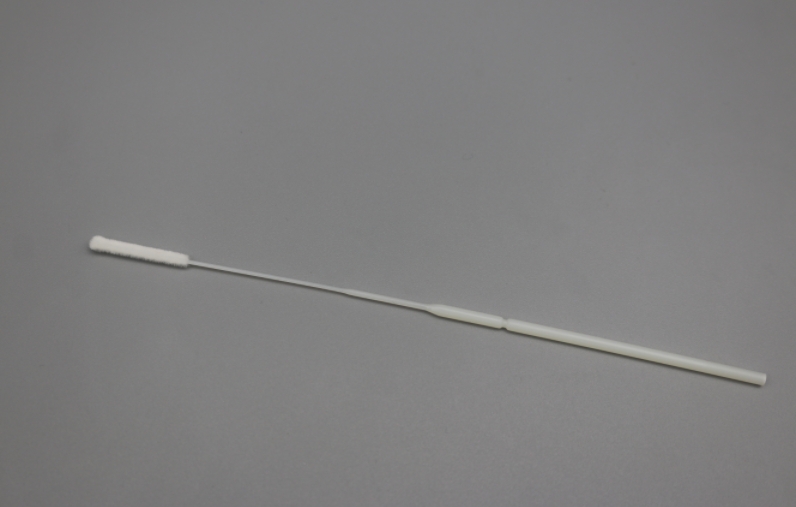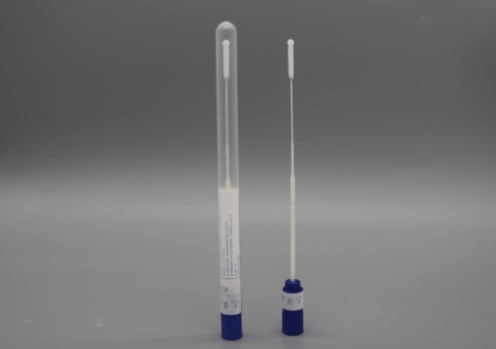Buy Flocked Nasopharyngeal Swabs for Specimen Collection
high-quality flocked nasopharyngeal swabs for reliable specimen collection
Why Choose Us?
As mastery lies in details, our specially crafted flocked swabs present perpendicular nylon fibers — a design that amplifies the process of specimen collection and seamless release into transport media. Prioritizing user convenience, our swabs integrate a unique molded breakpoint offering a secure and effortless way to detach the swabstick. Catering to the varying needs, we provide several breakpoint alternatives adaptable to an array of tube options.
Features and Benefits
Superior Sample Absorption and Recovery
The swabs manifest high liquid absorbency due to the robust capillary hydraulics amongst the nylon strands. Meanwhile, their velvet-like texture aids in the efficient dislodging, gathering, and transfer of solid and semi-solid specimens.

1
Prompt and Automatic Elution
Facilitating a quick elution mechanism, our swabs hold specimens close to the surface for spontaneous draining, when set in liquid or onto solid media.
2
Unobstructed Sample Release
Departing from the matrix core design seen in traditional fiber wound swabs, our swabs ensure an unimpeded release of samples, prohibiting any entrapment.
Recommended Nasopharyngeal Swabs
Instructions for Use
The advantages of flocked nasal swabs are as follows:
I. Comfortable sampling
- Soft material: The flocked material used in flocked nasal swabs is very soft. When inserted into the nasal cavity for sampling, it can greatly reduce the irritation to the nasal mucosa and reduce the discomfort of the person being sampled. Compared with traditional cotton or other materials of nasal swabs, it can make you feel more gentle during the sampling process.
- Reasonable front-end design: The shape and size of its front end are carefully designed. Usually, it is relatively slender and round, which can better adapt to the physiological structure of the nasal cavity and reduce the pain and damage that may be caused during sampling.
II. High sampling efficiency
- High adsorption: The flocked material has high adsorption, which can quickly and effectively adsorb secretions and cells in the nasal cavity to ensure that a sufficient sample size is collected. This is crucial for improving the accuracy of detection and can enable you to obtain more reliable detection results.
- Not easy to fall off: The collected samples can be firmly adsorbed on the flocked nasal swab and are not easy to fall off during the transfer process, ensuring the integrity of the sample.
III. Convenient operation
- Light and easy to use: Flocked nasal swabs are usually designed to be relatively light and easy for operators to hold and use. Whether it is a professional medical staff or an individual who performs self-sampling, they can easily master the usage method.
- Rapid sampling: Due to its high sampling efficiency and relatively simple and quick operation process, sampling can be completed in a relatively short time, improving work efficiency.
IV. High safety
- Non-toxic and harmless: The materials used in flocked nasal swabs are generally strictly screened and tested, non-toxic and harmless, and will not cause any adverse effects on the human body. Even in cases where nucleic acid testing is required frequently and nasal swabs need to be used multiple times, it can ensure your safety.
- Independent packaging: Usually in the form of independent packaging, avoiding the risk of cross-contamination and ensuring the safety of each sampling.

The correct usage method of flocked nasal swabs is as follows:
I. Preparation
- Clean hands: Before using the flocked nasal swab, you should carefully wash your hands. You can wash your hands with soap and running water or use an alcohol-based hand sanitizer for disinfection to reduce the risk of contamination.
- Confirm intact packaging: Check whether the packaging of the flocked nasal swab is intact. If the packaging is damaged or contaminated, do not use it.
II. Sampling steps
- Head posture: Slightly tilt your head back to make the nasal passage as straight as possible to facilitate the entry of the swab.
- Insert the swab:
- Hold the tail of the flocked nasal swab. Be careful not to touch the head of the swab.
- Gently insert the swab into one side of the nasal cavity and slowly push it in along the bottom of the nasal cavity. The insertion depth is generally appropriate when a slight resistance is felt, usually about 2-3 centimeters. During the insertion process, the action should be gentle to avoid excessive force and damage to the nasal mucosa.
- Rotate the swab: Gently rotate the swab in the nasal cavity for at least 4-5 turns to fully collect secretions and cells in the nasal cavity. During rotation, also pay attention to gentle movements to avoid discomfort.
- Remove the swab: Slowly remove the swab from the nasal cavity. During the removal process, avoid touching the nasal wall and other objects to prevent contamination of the swab.
III. Sample processing
- Send for inspection as soon as possible: Put the flocked nasal swab with the collected sample into a special sample collection tube to ensure that the head of the swab is completely immersed in the preservation solution. Then send the sample to the testing institution for testing as soon as possible to ensure the accuracy of the test results.
- Safe disposal: The used flocked nasal swab and packaging and other wastes should be properly disposed of in accordance with medical waste disposal regulations to avoid secondary pollution.
 A professional supplier of swabs
A professional supplier of swabs
